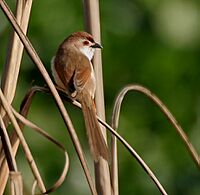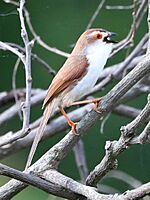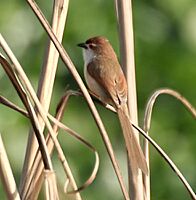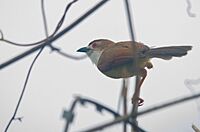Yellow-eyed babbler facts for kids
Quick facts for kids Yellow-eyed babbler |
|
|---|---|
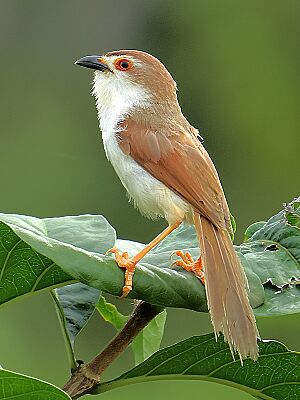 |
|
| Mangaon, Maharashtra, India | |
| Conservation status | |
| Scientific classification | |
| Genus: |
Chrysomma
|
| Species: |
sinense
|
| Synonyms | |
|
Pyctorhis sinensis |
|
The yellow-eyed babbler (Chrysomma sinense) is a small bird found in South and Southeast Asia. It lives in places with bushes, tall grass, and wetlands. This bird is listed as "Least Concern" on the IUCN Red List. This means it is not in danger of disappearing because there are many of them, and they live in a wide area.
This bird got its common name because it used to be grouped with a bird family called "Old World babblers." However, scientists now know that the Chrysomma group, which includes the yellow-eyed babbler, is actually related to parrotbills. They are all part of a family called Paradoxornithidae.
Contents
How Scientists Name Them (Taxonomy)
The yellow-eyed babbler was first officially described in 1789. A German scientist named Johann Friedrich Gmelin gave it the scientific name Parus sinensis. He based his description on notes from an English bird expert, John Latham. Latham had written about a "Chinese titmouse" in 1783.
Gmelin first said the bird came from China. Later, scientists narrowed this down to the Guangdong province in China. Today, the yellow-eyed babbler is placed in the genus Chrysomma. This group was created in 1843 by an English zoologist named Edward Blyth. Another bird, Jerdon's babbler, is also in this same group.
Scientists have found three main types, or subspecies, of the yellow-eyed babbler:
- One type lives in Sri Lanka.
- Another type is found in Pakistan, most of India, and southern Nepal.
- The third type lives from northeast India to southern China and Vietnam.
What They Look Like (Description)
The yellow-eyed babbler is about 18 centimeters (7 inches) long. It has a short beak and a long tail that gets wider at the end. Its back is brown, and its wings are a cinnamon color.
Around its eyes, adult birds have bright orange-yellow rings. The area between its eyes and beak, and above its eyes, is white. Its beak is black. The underside of its body is a pale, creamy white. The two feathers in the middle of its tail are about twice as long as the outer ones. It's hard to tell the difference between male and female yellow-eyed babblers just by looking at them.
Birds in different parts of their wide home range can look a little different. For example, the type found in Sri Lanka has black nostrils and a stronger beak. The type found across much of India has yellow nostrils, like the main type, but its feathers are lighter in color.
Where They Live (Distribution and Habitat)
The yellow-eyed babbler lives in many countries. Its range stretches from Pakistan across India, Nepal, and Sri Lanka. It also lives in Bangladesh, Myanmar, Thailand, Laos, Viet Nam, and China.
These birds usually live in areas with grass or thorny bushes. They can be found in both dry and wet places, as well as on farms. They mostly live in flat areas, but can also be found in lower hills up to about 1,200 meters (3,900 feet) high. They do not live in thick forests, like those in the Western Ghats of India. Instead, they prefer the edges of these forests or open areas.
How They Live (Behaviour and Ecology)
Yellow-eyed babblers usually live in small groups. These groups can have five to fifteen birds, especially when they are not raising young. They often stay hidden inside bushes. They might pop up to the top of a plant stem and then quickly dive back into cover to find food.
They mostly eat insects. However, they also eat berries from plants like Lantana and Salvadora. They also drink nectar from flowers. When they catch insects, they sometimes hold them down with their feet. The group makes constant soft chirping or churring sounds.
During the breeding season, which is mainly from June to August, the male bird sings a strong, clear song. It sounds like "twee-twee-ta-whit-chu." They often sing from a high spot where they can be seen. The inside of their mouth is said to change color from orange-brown to black during this time.
These birds seem to work together to build nests. The nest is shaped like a deep cone and is made from grass. It is lined with soft fibers. They build their nests by wedging them between upright plant stems. They even weave the vertical stems into the nest's walls. The outside of the nest is often covered with spiderwebs.
A female yellow-eyed babbler usually lays four eggs, but sometimes it can be three to five. The eggs are pinkish-white with reddish-brown spots. Both parents help to sit on the eggs and feed the young birds. The eggs hatch after about 15 to 16 days. The young birds are ready to leave the nest after about 13 days. Adult birds have been seen pretending to be hurt. They do this to distract predators, like other animals that might try to eat their young.
Yellow-eyed babblers sleep together in a group. They roost in the middle of a bush, all facing the same direction and sitting side by side. Birds in a group will also preen each other, which means they help clean and smooth each other's feathers. Sometimes, two pairs of birds will sing to each other as if they are showing off their territory. They will all bob their heads at the same time, standing tall on their legs.
Birds of prey, like Shikras, have been seen trying to hunt yellow-eyed babblers. In some parts of northern India, these birds are called gulab chashm, which means "yellow spectacles." They were sometimes kept as pet birds in cages.
Gallery
-
Perched on grass (Hodal, India)



